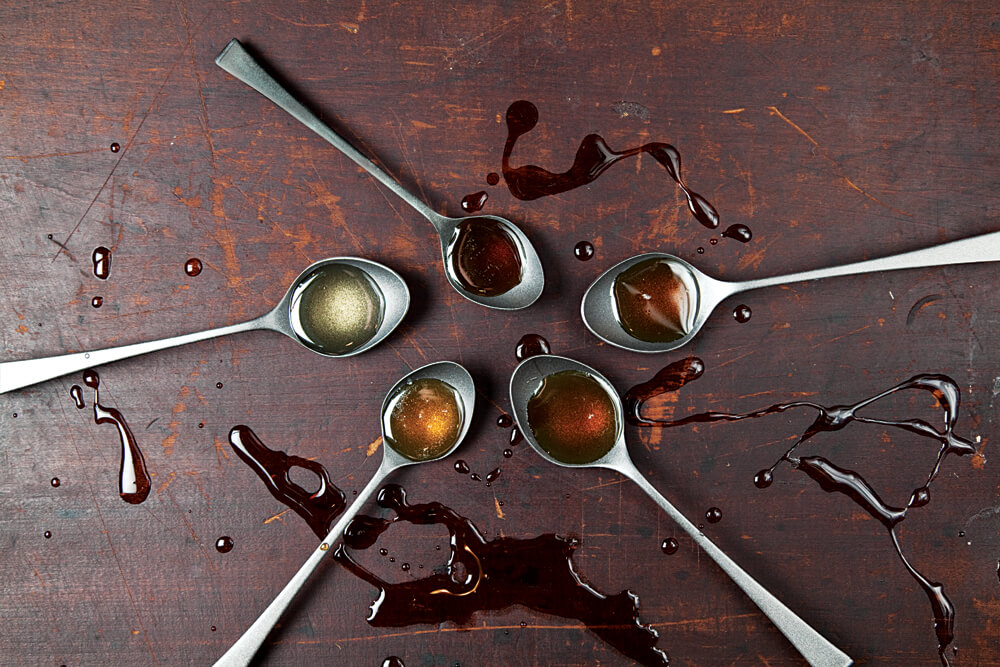Maple Syrup vs Honey
WHICH SWEETENER IS BEST?
Honey and maple syrup are two popular sweeteners that are often used as natural alternatives to table sugar.
While they do share some similarities, there are notable differences in the ways they are produced and can be used, as well as their nutritional profiles.
Getting to grips with these key differences will help you improve your cooking and allow you to make more informed decisions for your diet.
Maple syrup vs honey: production
Maple syrup is derived from the sap of maple trees, which are tapped during the spring season. The extracted sap is then boiled down to remove excess water until it reaches a thick consistency.
Honey is made by honeybees, which collect nectar from flowers and then transfer it to a beehive. Here, the nectar is processed by the bees and then dried, eventually forming honey.
Although both honey and maple syrup are obtained through natural methods, honey is not considered vegan because it is produced by animals.
Made solely from the sap of maple trees, maple syrup is vegan and can be enjoyed as part of a plant-based diet.

Many supermarkets in the UK stock honey blends, which are made by mixing honey sourced from different beekeepers and are sometimes even diluted with sugar syrup.
Pure Canadian maple syrup, on the other hand, is rigorously quality checked and will always be produced by maple farmers in Canada.
For these reasons, it’s important to check the labelling of honey and maple syrup when buying online or in-store, as the ingredients can have a significant impact on the quality of the product.
Maple syrup vs honey: taste
Maple syrup has a rich, caramel-like taste, with subtle notes of vanilla and butterscotch. Honey is slightly sweeter and often described as having a floral flavour.
Both sweeteners come in several varieties, with each having a unique taste. Honey varies based on its nectar source, while the different grades of maple syrup are collected in stages throughout spring.
In terms of baking and cooking, honey’s thicker consistency lends itself to marinades, dipping sauces and salad dressings.
Maple syrup can also be used in sauces, marinades and dressings, as well as a wide range of drinks, baked dishes and cooked meals – feel to explore our maple syrup recipes for inspiration!
Can you use maple syrup instead of honey?
Due to their similar textures, honey and maple syrup can generally be substituted for each other in a 1:1 ratio, though there will be a slight difference in flavour.
This makes pure maple syrup an excellent honey substitute for vegans as well as those seeking a richer taste from their sweetener.
And what about golden syrup? Learn more about the effects of substituting other sweeteners with maple syrup below.
Maple syrup vs honey: nutrition
When it comes to nutrition, maple syrup and honey are fairly similar, though there are some important differences in calories and macronutrients.
| 2 tbsp pure maple syrup (30ml) | 2 tbsp honey (30ml) | |
| Calories | 110 | 130 |
| Fat | 0.06g | 0g |
| Carbohydrates | 27g | 34g |
| Sugar | 24g | 34g |
| Protein | 0g | 0.2g |
| Calcium | 31mg | 2.6mg |
| Manganese | 0.8mg | 0.03mg |
| Riboflavin | 0.18mg | 0.06mg |
| Glycaemic index | 54 | 58 |
The nutritional data for honey is taken from the U.S. Department of Agriculture, while the data for maple syrup is sourced from our U.S. website.
Calories
Honey contains slightly more calories than maple syrup. A 30ml serving of honey provides 130 calories, while the same quantity of maple syrup offers 110 calories.
Although the difference isn’t huge, the calorie count can accumulate when using larger amounts of the two sweeteners while baking.
Carbohydrates
Honey also has a higher amount of carbohydrates than maple syrup. A 30ml serving of honey contains 34g of carbohydrates, predominantly in the form of fructose, a complex sugar.
In comparison, an equivalent serving of maple syrup contains 24g of carbohydrates, with around 12g consisting of sucrose.
Fat
Maple syrup contains a negligible amount of fat, at approximately 0.06g per 30ml, while honey is completely devoid of the substance.
Vitamins and minerals
Both honey and maple syrup contain various vitamins and minerals. Pure maple syrup is recognised as a source of riboflavin and manganese, while honey contains traces of vitamins B6 and C.
Glycaemic index
Maple syrup has a lower glycaemic index than honey, measuring 54 compared to 58. This means that maple syrup causes a slower increase in blood sugar levels.

Maple syrup vs honey: health benefits
As natural ingredients, honey and maple syrup are often linked to potential health benefits, with ongoing research seeking to substantiate these claims.
Studies have found both sweeteners to contain polyphenols, a category of compounds believed to have antioxidant properties. The presence of these compounds may explain why honey is often used as a home remedy for coughs.
In the case of maple syrup, there is evidence to suggest that some of the polyphenols found in the sweetener may decrease the risk of certain diseases and help alleviate periodontal tissue damage.
Comparing pure maple syrup with refined sugar, Canadian researchers found that maple syrup provided better outcomes for cardiometabolic health, including reduced abdominal fat and decreased systolic blood pressure.
There haven’t been any studies into the impact of replacing maple syrup with honey, however you learn more about the health benefits of maple syrup by following the link below.
So, is maple syrup healthier than honey?
To definitively answer the question “Is maple syrup healthier than honey?”, you need to consider your personal health.
For example, maple syrup is lower in calories than honey, and therefore may be the better choice for someone looking to lose weight.
Pure maple syrup also has fewer carbohydrates and is lower on the glycaemic index than honey, which may make it healthier for certain diets.
On the other hand, maple syrup does have more fat than honey, albeit only a very negligible amount.
Ultimately, maple syrup and honey are both high in sugar, and should therefore be consumed in moderation. That said, they both offer a natural alternative to processed sweeteners like table sugar.
)